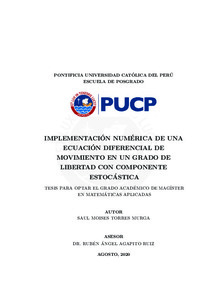| dc.contributor.advisor | Agapito Ruiz, Rubén Ángel | |
| dc.contributor.author | Torres Murga, Saul Moises | |
| dc.date.accessioned | 2020-10-07T21:39:35Z | |
| dc.date.available | 2020-10-07T21:39:35Z | |
| dc.date.created | 2020 | |
| dc.date.issued | 2020-10-07 | |
| dc.identifier.uri | http://hdl.handle.net/20.500.12404/17212 | |
| dc.description.abstract | En dinámica, mediante la ecuación diferencial ordinaria de movimiento, es posible determinar la posición en el tiempo de una masa que se desplaza debido a que es perturbada por alguna acción determinística. En este trabajo se propuso aplicar a la masa una perturbación no determinística de origen sísmico en un grado de libertad vertical y dentro del rango lineal. La pregunta de investigación fue: ¿será´ posible migrar la ecuación diferencial ordinaria (EDO) de movimiento hacia una ecuación diferencial estocástica (EDE) de movimiento? Bajo ese marco, se estudiaron los fundamentos de la teoría de la probabilidad y los procesos estocásticos. Utilizando estas ramas de las matemáticas aplicadas se logró obtener una EDE de movimiento. Se estudió también la aproximación de Euler-Maruyama la cual se implementó, luego de verificar su estabilidad estocástica y numérica, para obtener una solución de la EDE de movimiento encontrada. Los resultados obtenidos permitieron confirmar que el uso de una versión no determinística genera resultados satisfactorios. Se recomienda efectuar análisis similares con otras variables, por ejemplo, en sistemas con un grado de libertad diferente, con más de un grado de libertad y/o considerando un comportamiento no lineal. | es_ES |
| dc.description.abstract | In dynamics, using the ordinary differential equation of motion, it is possible to determine the position in time of a moving mass because it is disturbed by some deterministic action. In this work it was proposed to apply to the mass a non-deterministic disturbance of seismic origin in a vertical degree of freedom and within the linear range. The research question was: Will it be possible to migrate the ordinary differential equation (ODE) of motion to a stochastic differential equation (SDE) of motion? Under this framework, the foundations of probability theory and stochastic processes were studied. Using these branches of applied mathematics, an SDE of movement was obtained. The Euler-Maruyama approximation was also studied, which was implemented, after verifying its stochastic and numerical stability, to obtain a solution of the EDE of the movement found. The results obtained confirmed that the use of a non-deterministic version generates satisfactory results. It is recommended to carry out similar analyzes with other variables, for instance, in systems with a different degree of freedom, with more than one degree of freedom and / or considering non-linear behavior. | es_ES |
| dc.description.uri | Tesis | es_ES |
| dc.language.iso | spa | es_ES |
| dc.publisher | Pontificia Universidad Católica del Perú | es_ES |
| dc.rights | info:eu-repo/semantics/closedAccess | es_ES |
| dc.subject | Dinámica | es_ES |
| dc.subject | Probabilidad | es_ES |
| dc.subject | Procesos estocásticos | es_ES |
| dc.title | Implementación numérica de una ecuación diferencial de movimiento en un grado de libertad con componente estocástica | es_ES |
| dc.type | info:eu-repo/semantics/masterThesis | es_ES |
| thesis.degree.name | Maestro en Matemáticas | es_ES |
| thesis.degree.level | Maestría | es_ES |
| thesis.degree.grantor | Pontificia Universidad Católica del Perú. Escuela de Posgrado | es_ES |
| thesis.degree.discipline | Matemáticas | es_ES |
| renati.advisor.dni | 10168786 | |
| renati.advisor.orcid | https://orcid.org/0000-0002-5819-259X | es_ES |
| renati.discipline | 541137 | es_ES |
| renati.level | https://purl.org/pe-repo/renati/level#maestro | es_ES |
| renati.type | http://purl.org/pe-repo/renati/type#tesis | es_ES |
| dc.publisher.country | PE | es_ES |
| dc.subject.ocde | https://purl.org/pe-repo/ocde/ford#1.01.00 | es_ES |





